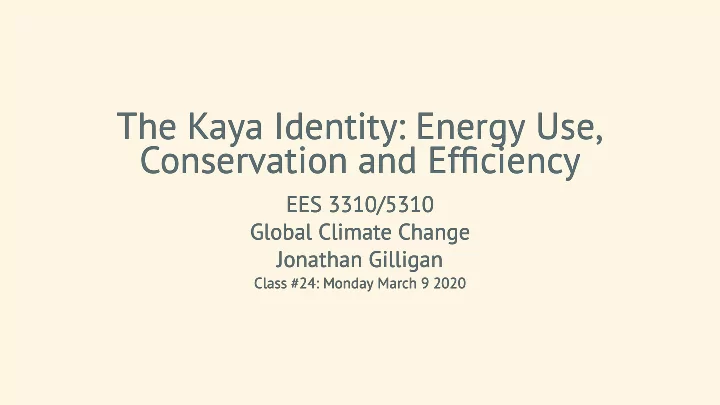

The Kaya Identity: Energy Use, The Kaya Identity: Energy Use, Conservation and Ef�ciency Conservation and Ef�ciency EES 3310/5310 EES 3310/5310 Global Climate Change Global Climate Change Jonathan Gilligan Jonathan Gilligan Class #24: Class #24: Monday March 9 Monday March 9 2020 2020
Announcements Announcements
Announcement Announcement Lab Today: Lab will meet in Stevenson 6740 (7th floor, EES Department) instead of our regular room. We will play a board game simulating converting New York City to renewable energy. I posted the rules for the game on Brightspace. If you haven’t done so, please read them before lab.
Midterm Exam Midterm Exam Median = B+ Average = 3.36
Decarbonizing Global Economy Decarbonizing Global Economy
Decarbonizing Global Economy Decarbonizing Global Economy World needs lots more energy National/industrial energy poverty: Energy consumption for economic growth Household energy poverty: Energy consumption for quality of life
Energy Energy Image credit: NASA
Population Density Population Density Image credit: NASA
Energy Poverty Energy Poverty Photo: Rebecca Blackwell, Associated Press, June 2007.
Household Energy Poverty Household Energy Poverty Roughly 1.2 billion people do not have acccess to electricity. Down from 1.5 billion in 2008 Benefits of providing even a little electricity: Children study 30% more with just one light bulb in home. Women have more say in household decisions Allows economically productive activity in evening Role of refrigeration in preventing disease Electricity and gas reduce exposure to indoor air pollution Indoor air pollution from cooking, lighting kills around 4.3 million/year Home solar typically provides light, but insufficient for refrigeration, cooking
Measuring Energy Measuring Energy and Environmental Impact and Environmental Impact
Measuring Energy Measuring Energy Heat: BTU (British Thermal Unit) = quantity of heat Quad = quadrillion BTU Kilowatt Hour (kWh): measure of electricity Conversions: 1 quad is about 300 billion kWh 1 quad per year is about 11 billion watts Typical large power plant (coal or nuclear) produces an average of around 750 million watts 1 quad per year is about 15 big power plants Magnitudes World uses about 550 quads per year of primary energy U.S. uses about 90 quads per year of primary energy 4% of population, 17% of energy consumption
Some De�nitions: Some De�nitions: Primary vs. Secondary Primary energy consumption = heat generated Secondary energy consumption = useful energy consumed Coal generation is about 33% efficient Gas generation is about 45% efficient A car engine is about 33% efficient More efficient generation can produce more secondary energy with less primary energy. Nameplate vs. Average Power Output: Nameplate = power when operating at 100% capacity Capacity factor = average fraction of maximum capacity achieved over a year Actual energy produced = nameplate power × capacity factor × 1 year
Kaya Identity Kaya Identity
Kaya Identity Kaya Identity F = P × g × e × f emissions (million tonnes carbon per year) F = population (billions) P = per-capita GDP ($1000 per person) g = energy intensity of economy (quads / trillion dollars) e = carbon intensity of energy supply (million tonnes carbon / quad) f = Policy Policy We can’t directly control P We want to grow g Therefore, decrease and e f
Economic and Energy Trends Economic and Energy Trends
Interactive Tool Interactive Tool https://ees3310.jgilligan.org/decarbonization/ Kaya data and analysis for your own computer: https://jonathan-g.github.io.kayadata install.packages ("kayadata") An experimental version of the interactive tool is available at https://github.com/jonathan-g/kayatool . You can install it on your own computer, but it may be a bit iffy when you run it.
Global Population ( Global Population ( P ) )
Global Economy (per-capita GDP Global Economy (per-capita GDP g )
Global Income Distribution Global Income Distribution Image credit: Y. Dikhanov & M. Ward, “Evolution of the Global Distribution of Income in 1970–99” (2001). Big drop in “desperate poverty” Growth of global middle-class
Global Income Distribution Global Income Distribution Image credit: B. Milanovic, Global Inequality (Harvard, 2016). Rightward movement of lower end: Big drop in poverty Growing lump in middle: Rise of global middle-class
Global Income Growth over Time Global Income Growth over Time Image credit: B. Milanovic, Global Inequality (Harvard, 2016). Biggest gains for 10 th –65 th percentile (poor and middle class) Losses for 80 th –85 th percentile (middle class of rich nations) Big gains for richest 5% (> $75,000 US)
Emissions Intensity of Global Economy ( Emissions Intensity of Global Economy ( ef ef ) )
Energy Intensity of Global Economy ( Energy Intensity of Global Economy ( e )
Carbon Intensity of Global Energy Supply ( Carbon Intensity of Global Energy Supply ( f ) )
Implied Decarbonization Implied Decarbonization
Implied Decarbonization Implied Decarbonization Specify emissions for 2050, compared to 2010 Assume global GDP grows at rate G r (5% → ) r = 0.05 emissions: F = Pgef = G × ef F (2050) = G (2050) × ef (2050) Growth: Growth: y (5 years from now) = y (today) × exp( r × 5) ≈ y (today) × (1 + r ) 5 exp = exponential function ( ). e x Call it “exp” to avoid confusing in Kaya formula with , base of natural logarithm. e e
Implied Decarbonization Implied Decarbonization Specify emissions for 2050, compared to 2010 Assume global GDP grows at rate G r (5% → ) r = 0.05 emissions: F = Pgef = G × ef F (2050) = G (2050) × ef (2050) G (2050) = G (2010) × exp( r × (2050 − 2010)) = F (2050) ef (2050) G (2050) F (2050) F (2050) = ≈ G (2010) × (1 + r ) 40 G (2010) × exp( r × 40)
Reduce emissions 50% by 2050: Reduce emissions 50% by 2050:
Actual and Implied Decarbonization Actual and Implied Decarbonization
Pielke’s Policy Criteria Pielke’s Policy Criteria 1. Policies should flow with public opinion 2. Public will not tolerate significant short-term costs, even for big long-term benefits 3. Policy must center on clean energy innovation
Recommend
More recommend